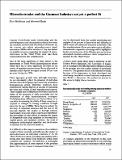| dc.contributor.author | Hoffman, Kurt | en |
| dc.contributor.author | Rush, Howard | en |
| dc.date.accessioned | 2016-04-08T09:23:39Z | |
| dc.date.available | 2016-04-08T09:23:39Z | |
| dc.date.issued | 01/03/1982 | en |
| dc.identifier.citation | Hoffman, K. and Rush, H. (1982) Microelectronics and the Garment Industry: not yet a perfect fit. The IDS Bulletin 13(2): 35-41 | en |
| dc.identifier.issn | 1759-5436 | en |
| dc.identifier.uri | https://opendocs.ids.ac.uk/opendocs/handle/20.500.12413/10688 | |
| dc.description.abstract | SUMMARY The garments sector is a major source of exports and employment in many Idcs. If automated technology were to become available, comparative advantage might revert to the developed countries. This is lent further importance by the fact that the basic technology is similar to that used in the shoe and leather industries which are also major sources of Idc exports. Garment technology has remained remarkably static over the last century and there have been few technological barriers to new entrants to the industry. However, the introduction of microelectronics technology is beginning to affect this and the advantages of low wage costs are beginning to be undermined. This article warns that emerging microelectronics technologies may erode the comparative advantages of developing countries which fail to adjustto the changing technological environment. RESUME La micro?électronique et l'habillement: une gêne aux entournures Le secteur de l'habillement est une source importante d'exportations et d'emplois dans bien des PVD. Avec l'automation, l'avantage relatif pourrait revenir aux pays développés, d'autant plus que les techniques de base sont analogues à celles de la chaussure et du cuir, importants secteurs d'exportation des PVD. L'industrie de l'habillement a peu bougé depuis un siècle, et les nouveaux venus n'ont pas jusqu'ici senti la contrainte des exigences techniques. La micro?èlectronique pourrait retourner la situation et minimiser l'avantage des bas salaires. Cet article met en garde les PVD qui ne sauront pas s'adapter à l'évolution technique. RESUMEN La microelectrónica y la industria del vestido: todavía no ajustan perfectamente El sector de la industria del vestido es una fuente importante de exportaciones y empleo en muchos países menos desarrollados. Si se dispusiera fácilmente de una tecnología automatizada, la ventaja comparativa podría pasar de nuevo a los países desarrollados. Esto adquiere aún mayor importancia por el hecho de que la tecnología básica es semejante a la utilizada en las industrias del cuero y el calzado, que también constituyen importantes fuentes de exportaciones de los países menos desarrollados. La tecnología de las prendas de vestir ha permanecido notablemente estática durante el último siglo y apenas han existido barreras tecnológicas para los nuevos participantes en la industria No obstante, la introducción de la tecnología microelectrónica comienza a influir en esto y empiezan a reducirse las ventajas de los costos salariales bajos. Este artículo constituye una advertencia de que las tecnologías microelectrónicas que empiezan a surgir pueden disminuir las ventajas comparativas de los países en vías de desarrollo que dejen de ajustarse a un ambiente tecnológico cambiante. | en |
| dc.format.extent | 7 | en |
| dc.publisher | Institute of Development Studies | en |
| dc.relation.ispartofseries | The IDS Bulletin Vol. 13 Nos. 2 | en |
| dc.rights.uri | http://www.ids.ac.uk/files/dmfile/IDSOpenDocsStandardTermsOfUse.pdf | en |
| dc.title | Microelectronics and the Garment Industry: not yet a perfect fit | en |
| dc.type | Article | en |
| dc.rights.holder | © 1982 Institue of Development Studies | en |
| dc.identifier.doi | 10.1111/j.1759-5436.1982.mp13002006.x | en |

